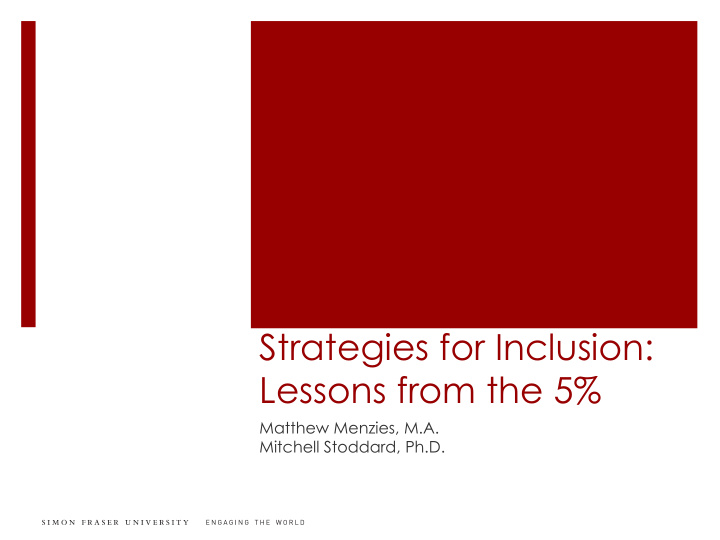



Strategies for Inclusion: Lessons from the 5% Matthew Menzies, M.A. Mitchell Stoddard, Ph.D.
Who are We? ¡ Simon Fraser University (SFU) ¡ Centre for Students with Disabilities (CSD) ¡ Who are CSD registrants (the “5%”) ¡ Accommodations
Workshop Outline ¡ Considering student-related factors in course design and delivery ¡ The value of focusing on the 5% ¡ Feedback from the 5%: what UDL course features are most impactful ¡ Actions that can be taken, based on what we’ve learned
Who is in the Room? A. Faculty/Instructors B. Instructional Designers C. Administrators D. Post-secondary Students E. Other
Who are “your” Students? ¡ What might you anticipate about the students in your classrooms?
Who are SFU Students? ¡ 55% are employed (75% of these work more than 10 hrs per week) ¡ 40% have a first language other than English ¡ 14% are International students ¡ Up to ~5% are registered at the CSD ¡ 17.5% have been diagnosed/treated for mental health conditions within the past 12 months - this doesn’t include other health conditions (2015 SFU Undergraduate Student Survey)
Who are SFU Students? 100% 84% 82% 80% 60% 52% 51% 49% 46% 38% 40% 19% 18% Past 2 weeks 20% 13% 7% 1% Past 12 months 0%
Why focus on the 5% Distribution curve
Methodology ¡ Compiled a list of 24 course design features that could make learning opportunities more inclusive ¡ Surveyed 700+ CSD registrants about UDL ¡ 171 respondents; 134 completed surveys ( ≈ 19%) ¡ Within survey, inquired about: ¡ diagnosis/impairments ¡ what course features would be most impactful ¡ how frequently are features already implemented ¡ what else instructors can do
UDL Course Features: Your Experiences
UDL Course Features: Survey of CSD Registrants ¡ Compiled 24 items (handout will be provided) ¡ Asked students to rank the 7 items that would make the biggest difference to them ¡ Also asked students to let us know how often they see these features in their courses
UDL Course Features: The “Top 5” Top 5 Features 1. Lecture outline and/or slides are provided before lectures 2. A flexible attendance policy allows students to access missed information and make up missed assessments if needed 3. Lecture audio recordings are provided after lectures 4. Students have some choice in the type of assessments they are graded on (e.g., choice between sitting exam vs. completing term paper or project) 5. Students' course grades do not rely significantly (e.g. >30%) on your performance on a given day (e.g., a single final exam or presentation)
UDL Course Features: The “Top 5” Top 5 Features “Often” or “always” present 1. Lecture outline and/or slides are provided 48% before lectures 2. A flexible attendance policy allows students to access missed information and 13% make up missed assessments if needed 3. Lecture audio recordings are provided 16% after lectures 4. Students have some choice in the type of assessments they are graded on (e.g., choice 5% between sitting exam vs. completing term paper or project) 5. Students' course grades do not rely significantly (e.g. >30%) on your performance 22% on a given day (e.g., a single final exam or presentation)
UDL Course Features: How to Operationalize? ¡ If you have seen this feature incorporated into the design of a course, how has it been done? ¡ If not, how might it be done?
UDL Course Features: How to Operationalize?
UDL Course Features: How to Operationalize? ¡ Flexible Attendance Policy ¡ Multiple assessment points; top X assessments used, or students have the ability to drop one (in contrast to re-weighting other grades) ¡ Copies of lecture materials available to students (e.g. slides, notes, recordings) ¡ Student Choice of Assessment Type ¡ Establish essential elements; so long as these are respected there is latitude for alternative means of demonstrating mastery
UDL Course Features: What SFU is doing well Features “Often” or “always” present Instructor is available for clarification of course content (e.g. office hours, email, 84% Canvas) Expectations of what students will learn and demonstrate are clearly articulated in the 71% course syllabus Instructor encourages a classroom environment/culture that is respectful of 61% diversity (e.g., of learning preferences, background knowledge/experience) The rubric for grading assignments is clearly 59% articulated and available in advance of completion of any assignment In a lecture or discussion, participation is 56% allowed to occur in real time or via submitted questions or comments
UDL Course Features: Looking for Trends Data was examined in terms of disability and then disability category AD/ Neurological Anxiety HD ASD Physical Depression LD Chronic Other MH Health “Health” “Learning Difficulties” “Mental Health”
How to promote change? ¡ Nesting within a ‘Healthy Campus’ Initiative ¡ SFU’s Healthy Campus Community ¡ Mission: “To engage and enable staff, faculty, students, administrators and community partners to work collectively towards creating campus conditions that enhance well-being and success for all.” ¡ Peer influence (e.g. ‘champions’) ¡ Nicky Didicher ¡ Senior Lecturer / English / Faculty of Arts and Social Sciences ¡ Enhances flexibility for students through "learner-centered teaching" and use of contractual evaluations, in which students choose their assignments, the weighting of the assignments, and due dates. ¡ "Every semester I want to make at least one significantly large change in the courses I teach”
Strategies for Inclusion: Lessons from the 5% Matthew Menzies, M.A. Mitchell Stoddard, Ph.D.
Recommend
More recommend